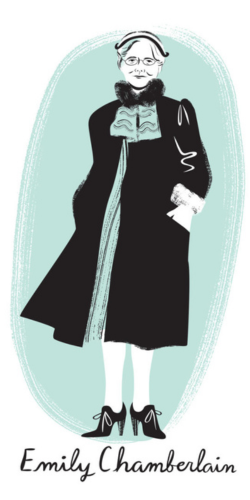Emily Chamberlin
By Jayson Otto
Life Dates: b. 1866, d. December 21, 1947
Full Name: Emily Mohl Chamberlin
Birthplace: Grand Rapids, MI
Tags: Community Activism, Women’s Clubs
For thirty years most of Chamberlin’s work was undertaken with the local Federation, and she led efforts to clean up a dirty city by working with and fighting against local politicians and business leaders. As chair of the Federation’s Civic Relations Committee, she persistently encouraged women to identify municipal “irregularities” to take up with the men in charge.
Looking back from 1934, a colleague commented that “women did not have the vote at that time and the only way we accomplished anything was to pester the life out of the men until we got it.”
Later in life, Chamberlin answered a question about her greatest achievement: “Without doubt the establishment of City Markets.” In 1916, as Federation president and chair of its Home Economics department, Emily Chamberlin had worked with future state senator Eva McCall Hamilton to expose a conspiracy between the city’s grocers and city aldermen. Farmers were being barred from selling directly to the public in order to preserve grocers’ monopoly on food retailing.

The women were appointed by the mayor to the High Cost of Living Commission, and two aldermen resigned before a city-owned farmers market opened on Leonard Street on July 4th, 1917. Chamberlin went on to chair food projects during WWI for the local branch of the Woman’s Committee of the Council of National Defense, and women flooded the city with petitions for more farmers markets. One opened in the southern part of the city in 1918, and the Fulton Street Farmers Market opened in 1922.
Chamberlin’s interest in civic well-being extended to the Grand Rapids Art Institute, which opened its first permanent home in 1924 under her direction, and the rest of her life continued a whirlwind of activity. Chamberlin and her early-20th-century cohort wrote an important chapter in the civic history of Grand Rapids and its women’s activism. They also underwrote many of the public services we take for granted today.
Mother of the Retail Market Idea
Chamberlin’s partner in the 1916 farmers market fight became our first female state senator, so historians rediscovered Eva McCall Hamilton first. In accounts of a well-publicized city meeting, where she “whipped five aldermen” fighting against farmers markets, the Grand Rapids Herald called her the “Mother of the Retail Market Idea.” The name was useful in her 1920 campaign.
While Hamilton earned that tag, Emily Chamberlin was the main force behind the early market movement. For decades, she sat on city advisory boards and, when grocers petitioned to close the Fulton Street Market in the 1920s and 1930s, Chamberlin counterattacked and won. But it took the work of Grand Rapids women Christine Helms-Maletic and Melissa Harrington in 2012 to enact Chamberlin’s desire for a roof!
Sources
This article can also be found in the November 2019 issue of the Grand Rapids Women’s LifeStyle Magazine.

